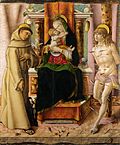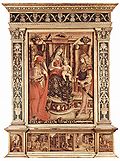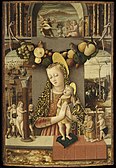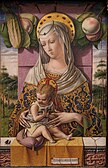art.wikisort.org - Artist
Carlo Crivelli (Venice, c. 1430 – Ascoli Piceno, c. 1495) was an Italian Renaissance painter of conservative Late Gothic decorative sensibility,[1] who spent his early years in the Veneto, where he absorbed influences from the Vivarini, Squarcione, and Mantegna. He left the Veneto by 1458 and spent most of the remainder of his career in the March of Ancona, where he developed a distinctive personal style that contrasts with that of his Venetian contemporary Giovanni Bellini.
This article may be expanded with text translated from the corresponding article in Italian. (July 2017) Click [show] for important translation instructions.
|
Carlo Crivelli | |
|---|---|
 The Annunciation, with St. Emidius (1486) National Gallery, London | |
| Born | Carlo Crivelli c. 1430 Venice, Republic of Venice (present day in Italy) |
| Died | c. 1495 (aged 64–65) Ascoli Piceno, Papal States (present day in Italy) |
| Nationality | Italian |
| Known for | Painting, tempera |
| Movement | Late Gothic/Renaissance |
Early life
Crivelli was born around 1430–35 in Venice to a family of painters and received his artistic formation there and in Padua. The details of Crivelli's career are still sparse:[2] He is said to have studied under Jacobello del Fiore, who was painting as late as 1436; at that time Crivelli was probably only a boy.[3] He also studied at the school of Vivarini in Venice, then left Venice for Padua, where he is believed to have worked in the workshop of Francesco Squarcione and then, after being sentenced in 1457 to a six-month prison term for an affair with a married woman, left in 1459 for Zadar in Dalmatia (now part of Croatia, but then a Venetian territory).
Career

He was master of his own shop when sent to prison for adultery in 1457. The dates he signed on the pictures that survive extend from 1468 on an altarpiece in the church of San Silvestro at Massa Fermana near Fermo to 1493 on The Dead Christ between St John, the Virgin and Mary Magdalene in Milan's Brera Gallery.[3]
Though the artist advertised his Venetian origins with his signature, often some variation on Carolus Crivellus Venetos ("Carlo Crivelli of Venice"),[4] Crivelli seems to have worked chiefly in the March of Ancona, and especially in and near Ascoli Piceno. Only two pictures can be found today in Venice, both in the church of San Sebastiano.[3]
He painted in tempera only, despite the increasing popularity of oil painting during his lifetime, and on panels, though some of his paintings have been transferred to canvas. His predilection for decoratively punched gilded backgrounds is one of the marks of this conservative taste, in part imposed by his patrons. Of his early polyptychs, only one, the altarpiece from Ascoli Piceno, dated 1473, survives in its entirety in its original frame, and still in its original location (the city's Cathedral). All the others have been disassembled and their panels and predella scenes are divided among several museums.
An amorphous band of contemporaries, imitators and followers, termed Crivelleschi, reflect to varying degrees aspects of his style.
Work

Unlike the naturalistic trends arising in Florence during his lifetime, Crivelli's style continues to represent the courtly International Gothic sensibility. His urban settings are jewel-like and full of elaborate allegorical detail. He favored verdant landscape backgrounds, and his works can be identified by his characteristic use of fruits and flowers as decorative motifs, often depicted in pendant festoons,[3] which are also a hallmark of the Paduan studio of Francesco Squarcione, where Crivelli may have worked.
His paintings have a linear quality identified with his Umbrian contemporaries. Crivelli is a painter of marked individuality. Unlike Giovanni Bellini, his contemporary, his works are not "soft", but clear and definite in contour with marked attention to detail. His use of trompe-l'œil, often compared with that found in the works of Northern Renaissance painters like Rogier van der Weyden, includes raised objects, such as jewels and armor modeled in gesso on the panel.
Commissioned by the Franciscans and Dominicans of Ascoli, Crivelli's work is exclusively religious in nature. His paintings consist largely of Madonna and Child images, Pietà, and the altarpieces known as polyptychs that were increasingly unfashionable. Often filled with images of suffering, such as gaping wounds in Christ's hands and side and the mouths of mourners twisted in agony, Crivelli's work fulfills the spiritual needs of his patrons. These ultra-realistic, sometimes disturbing qualities have often led critics to label Crivelli's paintings "grotesque",[citation needed] much like his fellow Northern Italian painter, Cosimo Tura. His work attracted numerous prestigious commissions and must have appealed to the taste of his patrons.
Carlo Crivelli died in the Marche (probably Ascoli Piceno) around 1495. Vittorio Crivelli, with whom he occasionally collaborated, was his younger brother. Pietro Alemanno, a painter who immigrated to the March of Ancona from Germany/Austria, was his pupil and collaborator. Donato Crivelli, who was also a pupil of Jacobello and was working in 1459, may be of the same family as Carlo.[3]
Reputation

His work fell out of favor following his death and Vasari's Lives of the Most Excellent Painters, Sculptors, and Architects, which is notably Florentine in its outlook, does not mention him. He had something of a revival, especially in the UK, during the time of the pre-Raphaelite painters, several of whom, including Edward Burne-Jones, admired his work. His reputation faded with that movement, but recent writings on his work and a rehanging of his work in the National Gallery, London, have brought him renewed attention.
Susan Sontag in Notes on "Camp" (1992) wrote: "Camp is the paintings of Carlo Crivelli, with their real jewels and trompe-l'œil insects and cracks in the masonry."[5]
Works
- 1472 Altarpiece, now divided up between a number of galleries in the United States and Europe.[6]
- Adoration of the Shepherds, Musée des Beaux-Arts de Strasbourg
- The Annunciation, with Saint Emidius, 1486, National Gallery, London. Possibly his most famous painting.
- An Apostle, c. 1471–73, Metropolitan Museum of Art, New York[7]
- Ascoli Piceno Altarpiece (or Saint Emidius Altarpiece), 1472–73, Cathedral of Saint Emidius, Ascoli Piceno. The only altarpiece entirely surviving, with its original XVth century carved wooden frame.
- Beato Ferretti, 1489, National Gallery, London
- Dead Christ, Vatican Gallery
- Enthroned Madonna, St. Jerome and St. Sebastian, 1490
- The Immaculate Conception, 1492[8]
- Lamentation over the Dead Christ, 1485, Museum of Fine Arts, Boston[9]
- Madonna and Child, 1480, Metropolitan Museum of Art, New York[10]
- Madonna and Child, 1460, Verona
- Madonna and Child, 1480–1486, Ancona
- Madonna and Child, Church of San Giacomo Maggiore[11] in Massignano
- Madonna and Child Enthroned, 1472, Metropolitan Museum of Art, New York[12]
- Madonna and Child with Saints, 1490
- Madonna and Saints, 1491, Berlin
- Madonna of the Candle, Brera of Milan
- Madonna of Poggio Bretta, c.1472, 71x50 cm, Ascoli Piceno, Diocesan Museum of Ascoli Piceno
- Madonna with child and saints, Monte San Martino in Marche
- Mary Magdalene, 1480, Rijksmuseum, Amsterdam[13]
- Pietà, 1476, Metropolitan Museum of Art, New York[14]
- Saint Dominic, 1472, Metropolitan Museum of Art, New York[15]
- Saint Francis with the Blood of Christ, 1480-1486
- Saint George Slaying the Dragon, 1470
- Saint James Major, part of an altarpiece, 1472, Brooklyn Museum
- Saint Stephen from the Demidoff Altarpiece, 1476, National Gallery, London
- San Giacomo, 1472 it:San Giacomo (Carlo Crivelli)
- St Thomas Aquinas, 1476, National Gallery, London
- Virgin and Child with Saints Francis and Sebastian, 1491
- Virgin Annunciate, 1482, Frankfurt
Another of his principal pictures is in San Francesco di Matelica.
Gallery of paintings
- Saint James Major, 1472
 Mary Magdalene, 1480
Mary Magdalene, 1480- Saint George, 1472
- Saints Peter and Paul, part of the Porto San Giorgio Altarpiece, 1470
- Saint Catherine, 1476
- The Virgin Annunciate, 1482 (detail)
- The Virgin and Child with Saints Francis and Sebastian, 1491
- Enthroned Madonna, St. Jerome and St. Sebastian, 1490
- St. Francis, 1476
- Dead Christ Supported by Two Angels, late 1470s, Philadelphia Museum of Art[16]
- Saint George Slaying the Dragon, part of the Porto San Giorgio Altarpiece, 1470
- Madonna with Child, c.1470, Macerata
- Madonna and Child, 1460, Verona
- Madonna and Child, 1480, Metropolitan Museum of Art, New York City
- Madonna and Child, 1480–1486, Ancona
- Saint Stephen, 1476, with three stones and the martyrs' palm
- Beato Ferretti (The Vision of the Blessed Gabriele), c. 1489, National Gallery
See also
- Crivelli carpet
- Huldschinsky Madonna (painting)
Notes
- "...a great fifteenth century artist, but one in whose paintings stylistic evolution is not the predominant interest", Ronald Lightbown began his monograph.
- Frey's monograph of 1927 is superseded by R. W. Lightbown, Carlo Crivelli (Yale University Press) 2004, which sums up the scholarship, much of it provided over several decades by the late Federico Zeri and sets Crivelli in the cultural context of the Marche in the fifteenth century.
- Rossetti 1911.
- From 1490 he added the title Miles, by then having been knighted (Cavaliere) by Ferdinand II of Naples.
- "Martin Irvine, Georgetown University".
- (in Italian) Pietro Zampetti, Carlo Crivelli, Nardini Editore, Firenze 1986.
- "An Apostle". Metropolitan Museum of Art. Retrieved 26 January 2016.
- "IDLE SPECULATIONS: Carlo Crivelli: The Immaculate Conception (1492)". 23 April 2007.
- "Lamentation over the Dead Christ". Museum of Fine Arts, Boston. Retrieved 26 January 2016.
- "Madonna and Child". Metropolitan Museum of Art. Retrieved 26 January 2016.
- "Chiesa di San Giacomo Maggiore".
- "Madonna and Child Enthroned". Metropolitan Museum of Art. Retrieved 26 January 2016.
- "A Medievalist at Amsterdam's Rijksmuseum". 6 July 2015.
- "Pietà". Metropolitan Museum of Art. Retrieved 26 January 2016.
- "Saint Dominic". Metropolitan Museum of Art. Retrieved 26 January 2016.
- Strehlke, Carl Brandon. "Dead Christ Supported by Two Putti by Carlo Crivelli (cat. 158)". The John G. Johnson Collection: A History and Selected Works. A Philadelphia Museum of Art free digital publication.
Sources
- Encyclopedia of Artists, volume 2, edited by William H.T. Vaughan, 2000, ISBN 0-19-521572-9
- Italian Art, edited by Gloria Fossi, ISBN 88-09-01771-4, 2000
- This article incorporates text from a publication now in the public domain: Rossetti, William Michael (1911). "Crivelli, Carlo". In Chisholm, Hugh (ed.). Encyclopædia Britannica. Vol. 7 (11th ed.). Cambridge University Press. p. 471.
External links
![]() Media related to Paintings by Carlo Crivelli at Wikimedia Commons
Media related to Paintings by Carlo Crivelli at Wikimedia Commons
- Carlo Crivelli at the Web Gallery of Art
- Carlo Crivelli at the National Gallery, London
- "Carlo Crivelli, The Annunciation, with Saint Emidius", The National Gallery, London,
- smARThistory: Madonna and Child
- Italian Paintings in the Robert Lehman Collection, plates 92–93, index
- Works at Open Library
- Miranda, Salvador. "CRIVELLI, Carlo (1736-1818)". The Cardinals of the Holy Roman Church. Florida International University. OCLC 53276621.
На других языках
[de] Carlo Crivelli (Maler)
Carlo Crivelli (* zwischen 1430 und 1435 in Venedig; † vor dem 7. August 1500 vermutlich in Ascoli Piceno) war ein italienischer Maler.- [en] Carlo Crivelli
[es] Carlo Crivelli
Carlo Crivelli (h. 1435 - h. 1495) fue un pintor italiano del Quattrocento, por tanto situado cronológicamente dentro del primer Renacimiento, pero con una sensibilidad decorativa propia todavía del Gótico tardío. Pasó sus primeros años en el Veneto, donde absorbió las influencias de Vivarini, Squarcione y Mantegna, y realizó la mayor parte de su obra en la Marca de Ancona, donde desarrolló un estilo distintivo personal que contrasta con su contemporáneo veneciano Giovanni Bellini.[fr] Carlo Crivelli (peintre)
Carlo Crivelli (né vers 1430/1435 à Venise et mort vers 1494/1495[1],[2] est un peintre italien de la Renaissance[3].[it] Carlo Crivelli
Carlo Crivelli (Venezia, 1430? – Ascoli Piceno, 1495) è stato un pittore italiano.[ru] Кривелли, Карло
Карло Криве́лли (итал. Crivelli Carlo; между 1430 и 1435, Венеция — 1495, Асколи-Пичено) — итальянский художник.Другой контент может иметь иную лицензию. Перед использованием материалов сайта WikiSort.org внимательно изучите правила лицензирования конкретных элементов наполнения сайта.
WikiSort.org - проект по пересортировке и дополнению контента Википедии








![Dead Christ Supported by Two Angels, late 1470s, Philadelphia Museum of Art[16]](http://upload.wikimedia.org/wikipedia/commons/thumb/0/0b/Dead_Christ_Supported_by_Two_Angels_c._1472.jpg/120px-Dead_Christ_Supported_by_Two_Angels_c._1472.jpg)






